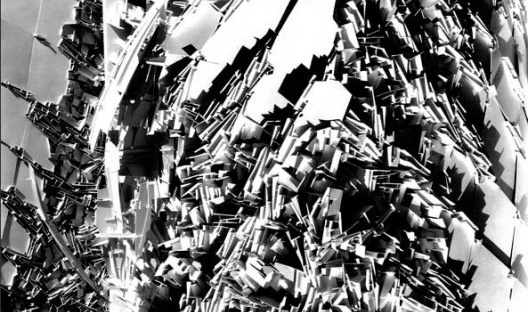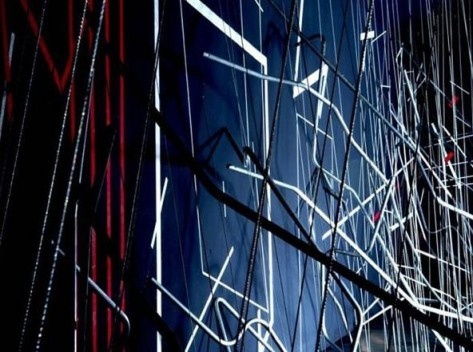
'Tectonic landscapes', 1999-2000 [lebbeuswoods.net]
Corrado Curti: You founded the Research Institute for Experimental Architecture in 1988, and have been directing it now for over 20 years. What role do you envisage for RIEA in relation to the issues discussed?
Lebbeus Woods: As you know, RIEA is being directed by a Board of Directors now and is more open and democratic than in the days when I had the greatest influence. I think that is a good development, especially considering the complexity of problems in the world today that confront architecture and that RIEA is engaging with. It is really my hope that RIEA will show leadership in identifying the most critical problems, clearly formulating them, and then contribute both concepts as well as analytical and design techniques towards some practical solutions.
Of course, this is already overly ambitious, but I think a group such as RIEA may be one of the few that can freely set the highest goals, because we don’t have a political or economic agenda. If we only get halfway there, that will still amount to a lot.
CC: The Building Industry is possibly the most reluctant sector to embrace innovation, both from a cultural and technological point of view. Tradition is a highly respected cultural value – even though it often hides cheap vernacularism and low-cost-low-quality building techniques – while technological innovation is mostly produced in other sectors - military, aeronautical and mechanical - before it is translated into architecture.
Frankly, I think to justify this by saying that only certain sectors can afford to invest in R & D, just isn’t good enough. The truth is that architects are struggling to find ways of boosting innovation in their own sector.
The UN estimates that architecture, as a profession, is affecting no more than 5% of what is being built worldwide. Proportionally, this indicates that architects are only responding to the needs of an extremely small, and affluent percentage of the world’s population. Does this mean that we, as architects, are incapable of forging change and becoming real innovators for fear of the risks and responsibility involved in addressing different fields of work and research? What role can architectural education adapt in relation to these questions?
LW: The most important part of education is asking questions. Young people entering schools of architecture are naturally curious, though they don’t always know what are the most important questions to ask for the future. With more experience in the world generally and in the field of architecture itself, their teachers should offer guidance by framing the most critical questions about what it means to be an architect in today’s world. This should be done in the design studio, where everything comes together, and not only in separate elective courses on ethics, politics, history.
In the high-pressure realm of professional practice, the really important questions usually don’t get asked and architects ride along on a wave of assumptions about what their responsibilities are and to whom. Architects’ associations are little more than dues-supported clubs. It’s only schools, really, where the tough questions get asked (5).
notes
5
Lebbeus Woods has written extensively about architectural education and the ideal form of an architectural school on his blog:
http://lebbeuswoods.wordpress.com/2009/01/28/architecture-school-101
http://lebbeuswoods.wordpress.com/2009/02/06/architecture-school-102
http://lebbeuswoods.wordpress.com/2009/02/16/architecture-school-201
http://lebbeuswoods.wordpress.com/2009/02/27/architecture-school-202
http://lebbeuswoods.wordpress.com/2009/03/18/architecture-school-301
http://lebbeuswoods.wordpress.com/2009/03/26/architecture-school-302
http://lebbeuswoods.wordpress.com/2009/05/15/architecture-school-401

‘System Wien’, Installations (series). Lebbeus Woods with Christoph a. Kumpusch and Reiner Zettl, Michlovsky/MAK (Museum for angewantde Kunst) and the First District, Vienna, Austria. 2005 [lebbeuswoods.net]



